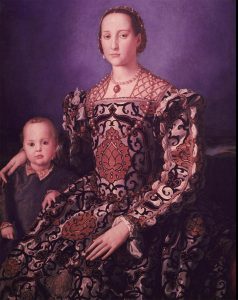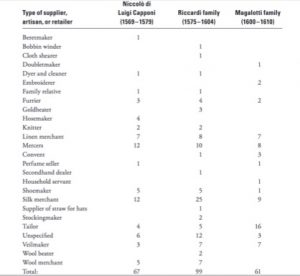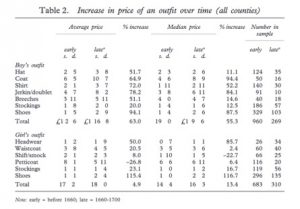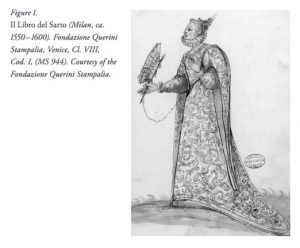Behind the Scene: The Costs, Collaboration and Commitment of Clothing Construction

This is Eleonora di Toledo, wife of the famous Cosimo I de’ Medici (Grand Duke of Tuscany) and her son Giovanni (Agnolo Bronzino, Eleonora of Toledo with Son Giovanni, c. 1544-5, http://library.artstor.org.prox.miracosta.edu/library/iv2.html?parent=true#). She was a member of one of the most famous, influential and powerful families in Italy, specifically Florence. The Medici family were also very influential and involved in the clothing economy and closely collaborated with many renown Florentine mercers, artisans, and merchants including Antonio di Ubertino Verdi (silk embroiderer), Gostanzo Gavazzeni (famous veilmaker) and Alessandro Chellini (mercer), to name a few. Almost every piece of her dress would have been constructed in Florence by artisans, mercers, merchants in collaboration with Medici family themselves, would have most likely taken anywhere from 8 months to 2 years to manufacture and would have also commonly required the expertise and skill of 20+ craftsmen and women (Currie, Elizabeth. “Fashion Networks: Consumer Demand and The Clothing Trade in Florence from The Mid-Sixteenth to Early Seventeenth Centuries.” Journal of Medieval & Early Modern Studies, (2009), Academic Search Premier. http://web.a.ebscohost.com.prox.miracosta.edu/ehost/pdfviewer/pdfviewer?vid=2&sid=a39381f0-3f13-4204-92ac-f1223e261688%40sessionmgr4010&hid=4104).

Much of the European world looked to Italy, specifically Florence, for fashion inspiration and for the export of their fine textiles, trims, garments and accessories, however, most garments being constructed were closely monitored. It is also estimated by Gregory King in other parts of Europe like England, that most people spent approximately 50% of their income on clothing (Spufford, Margaret. “The Cost of Apparel in Seventeenth-Century England, and the Accuracy of Gregory King.” The Economic History Review (2000), JSTOR Journals, http://eds.a.ebscohost.com.prox.miracosta.edu/eds/pdfviewer/pdfviewer?vid=1&sid=7907903c-e5bd-4114-b50f-046c9a18d841%40sessionmgr4007&hid=4105).

Since clothing was a collaborative effort fashion was pushed by both the consumer and the retailer/manufacturer and was therefore very distinct not only between nation states and countries but also between regions and classes. Yellow began as a color for the elite and slowly trickled down to commoners and even eventually to prostitutes (Rublack, Ulinka. “The Birth Of Power Dressing.” History Today, (2011), History Reference Center, http://prox.miracosta.edu/login?url=http://search.ebscohost.com.prox.miracosta.edu/login.aspx?direct=true&db=khh&AN=58087890&site=eds-live). Embroidered, trimmed, and highly decorated dress such as seen on Eleonora di Toledo was common for the wealthy, while the general population would have worn less popular colors, possibly fashionable the season before, as well as clothing made up of fewer layers and with less ornamentation. More and more consumers began to rely on mercers and tailors for fashion inspiration and dress designs which saw the creation of workshop books that displayed drawings that often the tailors were paid to produce. The only known surviving workshop book, the Libro del Sarto, which belonged to the Milanese tailor Gian Giacomo del Conte, provides a glimpse into the world of the fashionable elite (Currie, Elizabeth. “Fashion Networks: Consumer Demand and The Clothing Trade in Florence from The Mid-Sixteenth to Early Seventeenth Centuries.” Journal of Medieval & Early Modern Studies, (2009), Academic Search Premier. http://web.a.ebscohost.com.prox.miracosta.edu/ehost/pdfviewer/pdfviewer?vid=2&sid=a39381f0-3f13-4204-92ac-f1223e261688%40sessionmgr4010&hid=4104)

I am very curious about yellow here, since I thought in the Middle Ages it was a color of disrepute – I forget which town (Vienna?) prostitutes had to wear yellow scarves to identify them. It’s also a very common, cheap color – easy to produce. Is it Currie who denotes it as an elite color?
Good work on those secondary sources!
Well Currie did say that so perhaps the significance of the color was different between regions and/or perhaps it changed over time after during the transitional time between feudalism, distrust of the church, to the Renaissance. Just as colors, textiles and cuts go in and out of style now, so they did back then, although of course not nearly as rapidly. Currie doesn’t go into to detail about specific colors other than to say that white and black both both sexes was a way to express “sumptuous restraint”, purple was almost always reserved for bishops and how colors, like yellow, started out at “the top” with elite and eventually became a color known for prostitutes. Seeing as how this is the first time in history where fashion truly had the “trickle down” effect I’m assuming that other colors, textiles and cuts (within reason) experienced this as well. One color was popular for a period of time then as it reached those of ill repute it was no longer desirable for respectable women and at the same time other options would have become the style anyways…Does this not sound right?
You know what I’m sorry it was Currie who said that. It was actually Ulinka Rublack who for some reason I failed to cite although she is included in my bibliography
Rublack, Ulinka. “The Birth Of Power Dressing.” History Today 61.1 (2011): 20-27. History Reference Center. Web. 14 Oct. 2016. http://prox.miracosta.edu/login?url=http://search.ebscohost.com.prox.miracosta.edu/login.aspx?direct=true&db=khh&AN=58087890&site=eds-live